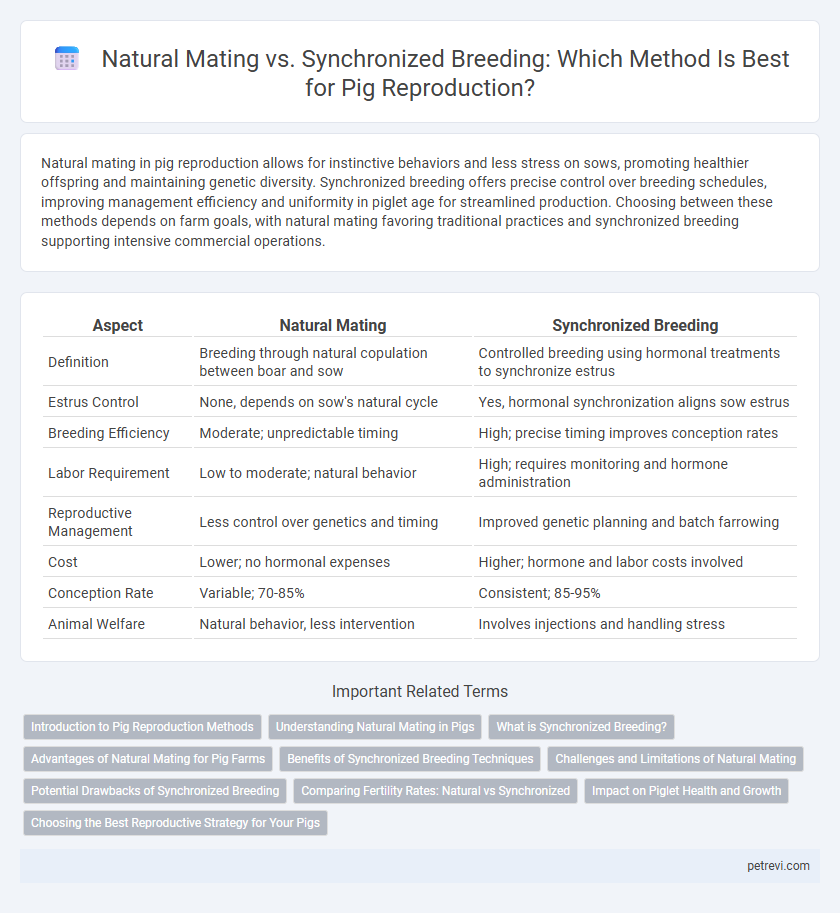Natural mating in pig reproduction allows for instinctive behaviors and less stress on sows, promoting healthier offspring and maintaining genetic diversity. Synchronized breeding offers precise control over breeding schedules, improving management efficiency and uniformity in piglet age for streamlined production. Choosing between these methods depends on farm goals, with natural mating favoring traditional practices and synchronized breeding supporting intensive commercial operations.
Table of Comparison
| Aspect | Natural Mating | Synchronized Breeding |
|---|---|---|
| Definition | Breeding through natural copulation between boar and sow | Controlled breeding using hormonal treatments to synchronize estrus |
| Estrus Control | None, depends on sow's natural cycle | Yes, hormonal synchronization aligns sow estrus |
| Breeding Efficiency | Moderate; unpredictable timing | High; precise timing improves conception rates |
| Labor Requirement | Low to moderate; natural behavior | High; requires monitoring and hormone administration |
| Reproductive Management | Less control over genetics and timing | Improved genetic planning and batch farrowing |
| Cost | Lower; no hormonal expenses | Higher; hormone and labor costs involved |
| Conception Rate | Variable; 70-85% | Consistent; 85-95% |
| Animal Welfare | Natural behavior, less intervention | Involves injections and handling stress |
Introduction to Pig Reproduction Methods
Natural mating in pig reproduction involves direct boar and sow interaction, promoting natural selection and genetic diversity. Synchronized breeding uses hormonal treatments to control estrus cycles, enabling scheduled insemination and improving herd management efficiency. Both methods influence reproductive success rates, with synchronization offering enhanced predictability and natural mating supporting genetic health.
Understanding Natural Mating in Pigs
Natural mating in pigs involves boars and sows interacting without human intervention, allowing instinctual behaviors to guide reproduction. This method supports natural selection, helping maintain genetic diversity and robustness in pig populations. Understanding natural mating is essential for farmers aiming to balance reproductive efficiency with animal welfare and genetic health.
What is Synchronized Breeding?
Synchronized breeding in pig reproduction involves controlling and aligning the estrous cycles of sows or gilts through hormonal treatments or management techniques to enable breeding within a specific timeframe. This method enhances reproductive efficiency by allowing coordinated insemination, reducing labor and resource use, and improving piglet uniformity. Compared to natural mating, synchronized breeding offers predictable farrowing schedules and optimized use of boar or artificial insemination resources.
Advantages of Natural Mating for Pig Farms
Natural mating in pig farms enhances genetic diversity and reduces the need for expensive technological inputs like artificial insemination equipment. It allows for more natural behavior expression in boars and sows, promoting better animal welfare and reproductive success. The direct interaction during natural mating also enables farmers to monitor sow receptivity and health more effectively, leading to higher conception rates.
Benefits of Synchronized Breeding Techniques
Synchronized breeding techniques in pig reproduction enhance herd fertility by enabling precise timing of insemination, leading to improved conception rates and uniform piglet birth dates. These methods optimize resource use, allowing for efficient labor management and better scheduling of farrowing and weaning processes. Additionally, synchronized breeding reduces the interval between litters, maximizing the sow's productive lifespan and overall herd performance.
Challenges and Limitations of Natural Mating
Natural mating in pig reproduction faces challenges including inconsistent heat detection, limited boar availability, and higher risks of disease transmission. These factors reduce breeding efficiency and lead to unpredictable farrowing intervals compared to synchronized breeding methods. The inability to precisely control breeding timing often results in lower reproductive performance and increased labor costs.
Potential Drawbacks of Synchronized Breeding
Synchronized breeding in pig reproduction can lead to increased management complexity and higher labor costs due to the precise timing required for hormone administration and monitoring. The practice may also reduce genetic diversity by limiting mating opportunities to a narrow timeframe, potentially impacting long-term herd resilience. Additionally, synchronized breeding can induce stress in sows, which may negatively affect fertility rates and overall reproductive performance.
Comparing Fertility Rates: Natural vs Synchronized
Natural mating in pigs typically results in fertility rates ranging from 75% to 85%, influenced by boar libido and sow receptivity, whereas synchronized breeding through hormonal protocols like PG600 and Altrenogest can enhance fertility rates above 90%. Synchronized breeding controls the timing of ovulation, allowing for precise insemination that reduces non-productive days and improves farrowing rates. Despite higher immediate fertility outcomes with synchronization, natural mating remains cost-effective and requires less labor, making both methods viable depending on herd management goals.
Impact on Piglet Health and Growth
Natural mating in pigs allows for better genetic diversity and instinctive behaviors, which can enhance piglet vitality and immune system development. Synchronized breeding, often using hormonal treatments to control estrus cycles, improves management efficiency but may increase stress levels in sows, potentially affecting piglet health and growth rates. Studies show that piglets from naturally mated sows generally exhibit stronger early growth performance compared to those from hormonally synchronized breeding programs.
Choosing the Best Reproductive Strategy for Your Pigs
Natural mating in pigs allows for instinctual breeding behaviors and can enhance genetic diversity, while synchronized breeding optimizes reproductive efficiency by controlling estrus cycles using hormonal treatments. Selecting the best reproductive strategy depends on farm goals, with natural mating suited for smaller operations prioritizing genetic variability and synchronized breeding favored in intensive systems aiming for uniform piglet batches and improved herd management. Evaluating factors such as labor availability, breeding schedule precision, and overall production targets ensures informed decision-making for maximizing reproductive success.
Natural Mating vs Synchronized Breeding for Pig Reproduction Infographic

 petrevi.com
petrevi.com